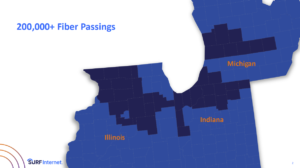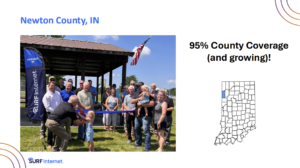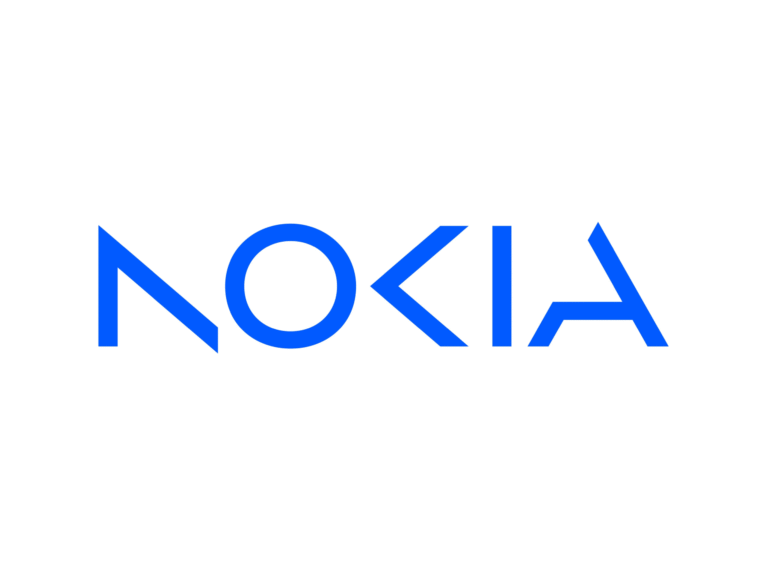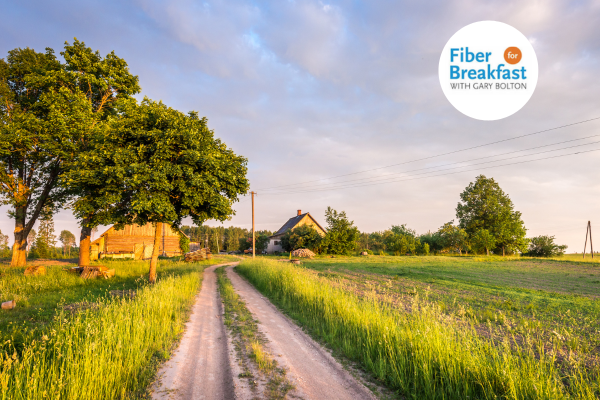Surf Internet’s 200K Fiber Passings – Accelerating Rural Deployment Across the Great Lakes
Surf Internet’s 200K Fiber Passings – Accelerating Rural Deployment Across the Great Lakes
Surf Internet has reached a major milestone—surpassing 200,000 fiber passings across Indiana, Illinois, and Michigan—doubling its reach since late 2023. In this week’s Fiber for Breakfast, Gene Crusie Surf Internet’s founder and CEO discusses this rapid growth with Gary Bolton, President & CEO of the Fiber Broadband Association and highlights Surf’s strategic commitment to rural broadband deployment and its role as a regional leader in delivering high-speed fiber connectivity across the Great Lakes.

Gene has spent over 25 years leading broadband innovation across the Midwest. From his early days bringing internet to Goshen College and launching one of Northern Illinois’ first ISPs, Gene has remained focused on a clear mission: transform connectivity in unserved and underserved areas through the power of fiber technology.
Headquartered in Elkhart, Indiana, Surf Internet has now surpassed 200,000 fiber passings across Indiana, Michigan, and Illinois—and the company shows no signs of slowing down. “We’re currently at 212,600 passings, increasing a few hundred every day,” Gene shared. “We’re trying to do 8,000 to 10,000 passings per month right now.”

Though rooted in technology, Gene is quick to emphasize Surf’s core identity: “Surf is a people business. We just happen to be transforming communities through fiber. 25 years ago, we did it by dial-up. In five years, we’ll probably be doing something else.”
Expanding Broadband Through Grit and Grants
One of the company’s standout efforts has been its multi-year investment in Newton County, Indiana. With a population under 14,000, Surf combined E-Rate funding, Next Level Connection grants, and its own capital to extend fiber across rural areas. The result? Roughly 95-97% of the county is now covered.
“We took a gritty approach,” Gene explained. “We invested where we could, and when public money wasn’t available, we filled the gaps ourselves. Now, we’re even partnering with a local fixed wireless operator to serve the last 200 very remote addresses.”
That hybrid strategy—fiber first, supplemented by fixed wireless—underscores Surf’s pragmatic model. While fiber remains the long-term goal, fixed wireless helps reach the hardest-to-connect households. “We currently have about 5,000 fixed wireless subscribers and 500 towers across the region,” said Gene.
Navigating BEAD and Beyond
As federal broadband initiatives evolve, Surf remains deeply engaged. The company is actively pursuing funding through the Broadband Equity, Access, and Deployment (BEAD) program in Indiana, Illinois, and Michigan—and is pre-approved in Wisconsin.
Despite delays in BEAD rollout, Surf is pressing ahead. “We’re taking a pretty aggressive approach,” Gene noted. “We’re presenting a project to our board that will reach 5,000 rural passings before BEAD funds even arrive.”
When asked about BEAD’s new flexibility in defining funding areas, Gene acknowledged both opportunity and risk. “Yes, it will increase participation, but it may also leave some people behind,” he cautioned. “Illinois started with the hardest-to-reach areas. Those projects are the most expensive.”
Overcoming Permitting Roadblocks
Gene also addressed one of the industry’s biggest hurdles—right-of-way access and permitting. “In Illinois, we won a $10.8 million grant, but 70% of those addresses are stranded by parcels with no right-of-way. Some are owned by absentee landlords, or held in trusts. It’s extremely complex,” he explained.
To solve it, Surf launched a postcard campaign with QR codes and followed up with door-to-door outreach. “We’re down to about 15% unresolved, and working with county commissioners and even state officials to help move things forward.”
A Blueprint for Communities
Surf’s leadership extends beyond deployment. The company published a book to help local leaders understand the intricacies of broadband construction—from utility permitting to aerial vs. underground buildouts.
“We wanted to be seen as a resource,” said Gene. “Our goal was to educate small towns so they could anticipate what’s coming and hopefully become active partners. Between grants and local collaboration, we’ve raised over $60 million in matching funds.”
Fiber’s Future: Speed, Value, and AI
Gene believes the promise of fiber goes far beyond fast internet. “Unlimited, future-proof fiber is going to unlock innovations we can’t even imagine,” he said. “My youngest son grew up with always-on connectivity. Add AI to that, and the changes will be exponential.”
Surf currently offers speeds up to 8 Gbps, with approximately 15% of customers opting for this tier. The most popular plan is a symmetrical 1 Gbps package, priced at around $71 per
month. In comparison, the fixed wireless service costs $83 per month for just 25 Mbps down and 3 Mbps up, versus $71 per month for fiber at 1,000/1,000 Mbps—making fiber upgrades an easy sell.
Despite fixed wireless limitations, Gene sees its value in bridging gaps. “If you do it right, fixed wireless can offer a great experience. But physics limits how much data you can push through the air. Fiber is the long game.”
Looking Ahead
Surf Internet plans to build 85,000 new fiber passings in 2025, with sights set on reaching 500,000. As they scale, their approach remains the same: blend tenacity, community partnership, and a commitment to serving the unserved.
Even outside the office, Gene embodies endurance—he’s training for Ironman Maryland this September. “This one’s for a friend—it’ll be my last full Ironman,” he smiled. “Just pray for no jellyfish.”
Click here to listen to the full episode or find previous episodes of Fiber for Breakfast.
Click here for the slides presented during the interview.




